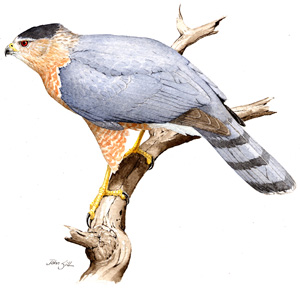Find a Bird
Cooper's Hawk
Accipiter cooperii

Widespread and strongly increasing
"Here is no ally of the farmer, but his foe, the most bold of all his robbers, a blood-thirsty villain that lives by plundering poultry yards, and tearing the warm flesh from the breasts of game and song birds..." – Neltje Blanchan, Birds Every Child Should Know
As the above quote suggests, in times gone by there has been little love lost between humankind and Cooper’s Hawks. Larger and more powerful than their cousins the Sharp-shinned Hawks, Cooper’s Hawks have been historically despised by farmers for stealing poultry, by hunters for devouring game birds, and by backyard bird watchers for killing songbirds. Times have changed, and for the most part anyone who has seen a Cooper’s Hawk pursue and capture its quarry will acknowledge its impressive speed and grace in flight, and many people now welcome the bird as a signature predator of a healthy woodland.
Historic Status
William Peabody had to take Samuel Cabot, Jr., of Cambridge, his friend and bird shooter of no mean ability, at his word when he said that he had taken a Cooper’s Hawk in his hometown in the 1830s (Peabody 1839). This was notable since this was a new species, having been properly described and named in 1828. Despite farmers’ attempts to cull the population, Cooper’s Hawks thrived in Massachusetts until the beginning of the twentieth century (Forbush 1927). Thereafter, a decline began, later accelerated by the same cause that took down the Peregrine Falcon and other birds of prey in the aftermath of World War II – pesticide poisoning.
Atlas 1 Distribution
Brushes with toxic pesticides and a talent for staying on humanity’s bad side had reduced the Cooper’s Hawk’s Massachusetts breeding population to a shadow of its former self by the time of Atlas 1. Along with the species’ elusive behavior while nesting, the highly localized distribution of records for this species speaks to its former status as a fairly rare breeder. Never found in more than 3 or 4 blocks per region, Cooper’s Hawks may have been under-reported in the forested Berkshires. A Confirmation in the Connecticut River Valley was the most eastward record until the Coastal Plains, where Cooper’s Hawks were found in 2% of blocks scattered about the region. Three accounts of Possible breeding in the northern Bristol/Narragansett Lowlands further suggested that the species was not common during Atlas 1.
Atlas 2 Distribution and Change
The scale of recolonization for this species is undeniably massive. Even though the westernmost ecoregions witnessed some expansion, the really remarkable increases occurred from the Connecticut River Valley eastward. Cooper’s Hawks were newly reported in more than half of all blocks in the Connecticut River Valley and the Worcester Plateau, with the Lower Worcester Plateau not far behind. The Coastal Plains and the Boston Basin experienced similar rates of colonization as Cooper’s Hawks proved that they were more than able to accept wooded suburbs as breeding habitat in Massachusetts. Though range expansion in the Bristol/Narragansett Lowlands and the Cape and Islands was more modest, it is all the more extraordinary considering what little presence Cooper’s Hawks had in those regions during Atlas 1.
Atlas 1 Map

Atlas 2 Map

Atlas Change Map

Ecoregion Data
Atlas 1 | Atlas 2 | Change | ||||||
Ecoregion | # Blocks | % Blocks | % of Range | # Blocks | % Blocks | % of Range | Change in # Blocks | Change in % Blocks |
Taconic Mountains | 0 | 0.0 | 0.0 | 3 | 12.0 | 0.6 | 2 | 13.3 |
Marble Valleys/Housatonic Valley | 2 | 5.1 | 13.3 | 13 | 33.3 | 2.4 | 11 | 28.2 |
Berkshire Highlands | 2 | 3.6 | 13.3 | 15 | 27.3 | 2.8 | 12 | 22.6 |
Lower Berkshire Hills | 1 | 3.6 | 6.7 | 11 | 35.5 | 2.1 | 10 | 37.0 |
Vermont Piedmont | 0 | 0.0 | 0.0 | 8 | 47.1 | 1.5 | 5 | 41.7 |
Berkshire Transition | 1 | 2.6 | 6.7 | 20 | 50.0 | 3.8 | 14 | 45.2 |
Connecticut River Valley | 2 | 3.6 | 13.3 | 35 | 53.8 | 6.6 | 26 | 54.2 |
Worcester Plateau | 0 | 0.0 | 0.0 | 51 | 58.0 | 9.6 | 31 | 64.6 |
Lower Worcester Plateau | 0 | 0.0 | 0.0 | 44 | 55.0 | 8.3 | 26 | 48.1 |
S. New England Coastal Plains and Hills | 4 | 1.5 | 26.7 | 195 | 68.9 | 36.7 | 154 | 68.1 |
Boston Basin | 0 | 0.0 | 0.0 | 30 | 53.6 | 5.6 | 30 | 54.5 |
Bristol and Narragansett Lowlands | 3 | 2.8 | 20.0 | 45 | 39.5 | 8.5 | 38 | 37.6 |
Cape Cod and Islands | 0 | 0.0 | 0.0 | 61 | 42.4 | 11.5 | 52 | 43.3 |
Statewide Total | 15 | 1.5 | 100.0 | 531 | 51.2 | 100.0 | 411 | 49.6 |



